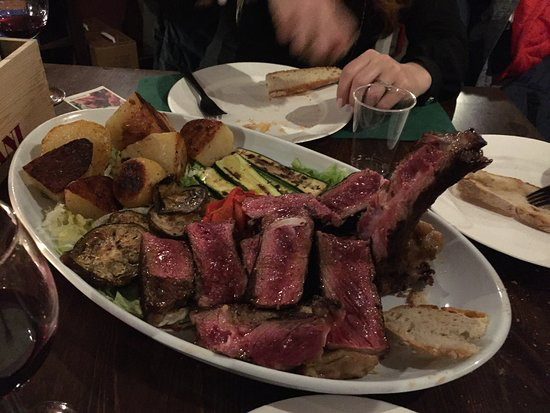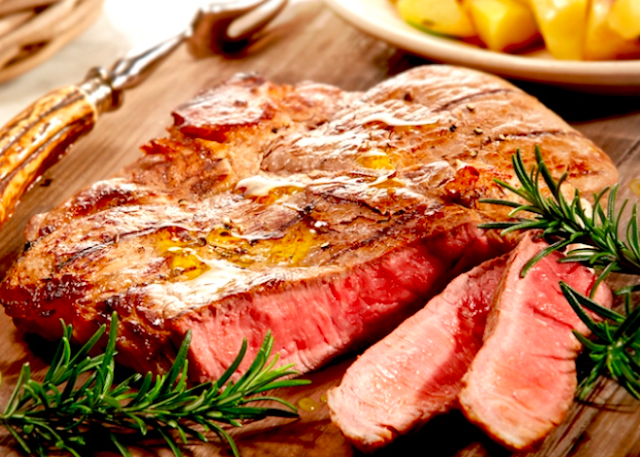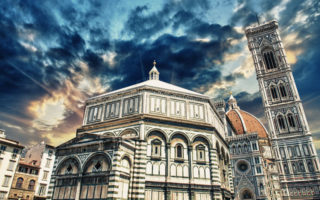Staking Out Florence’s Finest Bistecca Alla Fiorentina
There’s an old Tuscan proverb that perfectly captures Florence’s culinary culture: “chi non carneggia, non festeggia”—“those who don’t eat meat don’t know how to celebrate.” Bold, red-blooded, and brash—especially at a time when vegetarianism is steadily on the up—it speaks volumes of a city in which the main specialties are lampredotto(the fourth layer of a cow’s stomach, typically served in a sandwich) and bistecca (a mouthwatering mound of rare T-bone steak). But the potency of the proverb comes from how it conceptually links the two: meat feasting and festivities have always gone hand in hand, and have always been the preserve of special occasions.
Historically speaking, meat eating, though an integral part of our diets, used to be limited on the basis of availability. In Italy, it was only after World War II that people started to eat meat (or rather steak) in any significant quantity. This was partly owing to the country’s rugged landscape—unsuitable for cattle grazing unlike the vast plains of Argentina, the American South and other areas renowned for the quality of their beef. And it was partly owing to financial factors; relative poverty, especially in the South of Italy, preventing people from adopting a red meat diet. That was, at least, until Italy’s economic boom of the 1950s and 60s.
The boom brought about exponential growth in capital and consumption. And although cars are the most enduring symbol of the era, carnedidn’t do too badly either—particularly the Bistecca alla Fiorentina. The steak comes the Chianina—a strong contender for the world’s most revered cattle outside India. They’re big beasts, with mature bulls reaching up to 5”11 and castrated oxen up to 6”7. They’re also historically well attested across the regions of Tuscany, Lazio and Umbria. All the way back in the 1st century AD, the Roman author and agriculturalist Columella described these Umbrian cattle as being “vastos et albos” (huge and white). Two thousand years later the description still stands.
For centuries Chianina oxen were put to agricultural use because of their size and strength. Then with the industrialization of Italian agriculture, which reached an apex in the 1970s, they became redundant for this purpose. Since then they’ve been bred exclusively for their meat. And their quality hasn’t gone unnoticed: China, Russia, and the US are just three of the countries that import frozen Chianina semen and embryos. Lovely.
A brief history of the Bistecca alla Fiorentina
 |
| Donetto, the world’s heaviest Chianina bull (1740 kg) in 1955. Wikipedia Commons |
Etymologically, the Italian bistecca derives from the English “beef steak”, and its usage can be traced back to an act of largesse from 23 March 1565. The story goes that during the wedding celebrations of his daughter Isabella, the Duke of Florence decided to roast an entire ox in the middle of Piazza San Lorenzo and dole it out to the populace. A passing group of English knights saw what was happening and, doing the nation proud in their stereotypically British appreciation for the brisket, shouted “beef-steak! beef-steak!” And alas a legend was born.
The bistecca fared well (better at least than the Chianina that produced it) throughout the late 20thcentury. That is until the period between April 2001 and December 2005. In the wake of the outbreak of Mad Cow Disease, the EU banned the sale of the Bistecca alla Fiorentina, prohibiting cuts from cows over 12 months old (the Fiorentinacomes from cows of around 18 months) and which had the bone still attached. The Italians however—ever able to interpret laws as mere guidelines—improvised. Either they continued to sell cuts without the bone, or—to customers they trusted—they just disregarded the law altogether and sold it as it came.
How it comes
So what should you expect from this world-renowned slice of steak? Don’t expect to be asked how you want your steak cooked. The Bistecca alla Fiorentina comes just one way – rare, bloody, and delicious. Asking for it well done wouldn’t just risk earning the enmity of your of your waiter, it would also ruin the meat which—if cooked for too long—becomes as tough as leather.
You typically order your steak by the kilogram and pay anywhere from 35 – 50 euros per kilo. Don’t think you need any sauce. A sprinkle of salt and a drizzle of extra virgin olive oil on your plate is more than enough. And keep the sides simple: roast potatoes (or chips), sautéed spinach, or white cannellini beans.
Regardless of whether you’re a carnivore or not, there’s a seemingly unlimited range of options when dining in Florence. But for the meat eaters among you, don’t pass up the opportunity to chew your way through a steak or two during your time here. Want to know where to get Florence’s finest fillet? Let us at Roman Candle Tours take you through the best the city has to offer.
Where to go for the best Bistecca alla Fiorentina
I’Tuscani 3, Via Dante Alighieri 18r
 |
| Photo credit: Tripadvisor |
I’Tuscani 3is tucked away on a narrow street just off one of Florence’s more characterful piazzas between the Duomo and the Piazza della Signoria. Seemingly small from the outside, it’s TARDIS-like from within, spanning two floors of bustle, chatter and the alluring smell of cooking meat. I went there with some friends from Texas who, coming from a landscape populated almost exclusively by cattle, know a thing or two about red meat. They agreed it was hands down the best steak they’d ever eaten.
Our waiter was a young Sicilian. He was completely rushed off his feet; his face the flush of an uncooked Rib eye as he attended all the tables on our floor single-handedly. But in spite of this he was really friendly—not a given in Florentine restaurants—although he did point blank refuse to accept our initial order of the mixed grill. Our decision, he informed us, was wrong. “You’ve come to a steakhouse, you’re mad not to get the steak,” he said, sounding almost hurt.
Such was the size of our starter that it nearly finished us off. Local Tuscan meats (supposedly cured; decisively dead), cheeses, chutneys, crostini, and, to top if off, a thick tomato soup served in a basket of thin, crunchy bread. Having cleared our plates, we sat back, sipped our wine and waited for the main event. And when it arrived we weren’t disappointed.
He brought us each a T-bone steak roughly the size of our heads. They were beautifully presented, resting upon a bed of lettuce, served with potatoes and grilled vegetables. And they tasted even better: juicy, melt in your mouth tender, kind of like the best steak in the world really…
Trattoria Osteria Da Que’ Ganzi, Via Ghibellina 70
Photo credit: Tripadvisor
I’ve been coming to Da Que Ganzi for years, so much so that I’m on first name terms with the owner. It’s my first port of call when introducing someone new to the city, partly because of the quality of the food, partly because of the consistency of said quality, and partly because I’m an incorrigible creature of habit.
Their websitemight be just about the cheesiest thing you’ve ever seen (seriously, just click on it) but the restaurant itself is rather more rustic and understated. They’re open six days a week for lunch 12:00 – 2:30 p.m. and dinner 7:00 – 11.30 p.m. (closed on Tuesdays). And I’m going to go out on a whim here and say you don’t have to book in advance. I’ve never had a problem getting a table by just walking in. Then again, I may single-handedly be keeping them in business…
The owner, Domenico, goes out of his way to recommend the right wine to go with your meal, although I feel I’ve increasingly disappointed him in recent months by consistently going for the house red… And the variety and versatility of their menu—with its exquisite starters, seafood, meats and pasta dishes—keeps him on top of his game.
I’d recommend starting off with the tagliere “dei Ganzi” to share before moving on to the bistecca. Sharing is caring when it comes to the Bistecca alla Fiorentina. And I say this not just because of their size, but because there’s something about feasting on a chunk of red meat with someone else that runs deep in our anthropological makeup. But if nobody’s willing to go twos with you don’t panic. Da Que Ganzi also offers the smaller tagliata di manzo ai carboni (sliced beef cooked on coals) for one or filetto di manzo ai carboni (fillet steak cooked on coals). Don’t miss out on their dolci either. They’re molto buoni.
Trattoria Mario, Via Rosina 2r
Photo credit: Tripadvisor
Mario’s is almost as much a part of Florence’s cultural heritage as David and the Duomo. Hidden away just out of sight of the Mercato Centrale(another foodie heaven well worth the visit) Mario’s doesn’t look like much from the outside; its windows and door plastered in review snippets, black and white photo clippings and a generous helping of Fiorentina FC memorabilia. But ask any Florentine where you can find the best steak in the city (excluding establishments owned by friends or family) and chances are they’ll point you here.
Owned by the Colzi family for three generations, Mario’s is a restaurant where tradition reigns supreme: a point emphasized in a video of almost Spielbergian length made to celebrate its 60thanniversary. There’s no question their pièce de résistance is the Bistecca alla Fiorentina. But it’s by no means the only dish they do exceptionally well.
Every Wednesday they serve up braciola(pan-fried meat), and Friday is fish day; all produce arriving fresh on the day from Mercato Centrale. Just bear in mind that a series of commandments have grown up around the cult of Mario’s. Thou shalt not ask for coffee, ketchup, mayonnaise, or Wi-Fi. And make sure to avoid the deadliest sin of all: uttering the name of Fiorentina FC’s archrival, Juventus.
Trattoria Mario is only open for lunch (12:00 – 3:30 p.m.) and is closed on Sundays. They don’t accept credit cards or take reservations, so it’s definitely worth arriving 10 minutes early. It’s intimate too; whichever of its confined, crowded couple of floors you’re assigned to, expect to share a table with others. Just remember there’s a reason why, in spite of the restaurant featuring in almost every guidebook about the city, locals and tourists alike continue to flock to Trattoria Mario for a spot of pranzo.
Ristorante Buca Mario, Piazza degli Ottaviani 16r
Photo credit: Tripadvisor
“¡Un insult a la pobreza!” is how my Mexican friend’s mum described the enormous chunk of Bistecca alla Fiorentina being lugged to a nearby table when she went to Buca Mario a few months back. What she’d seen was the latter of the four options you have when ordering the steak: the one for four people. You can also order it for one, two, or three. But, as already mentioned, remember that the Bistecca alla Fiorentina really is for sharing.
Buca Mario has been going since 1886. It’s only open in the evenings (7:00 – 10:00 p.m.) and you’d do well to book in advance (by calling +39 055 214179) as it gets very busy, especially during high season. Despite how busy they get, the service is always phenomenal: personal, accommodating, and attentive. That’s to be expected, though. Buca Mario sits on the pricey side of Florence’s eateries, able to ride off its long-established reputation. And it’s a reputation that’s earned the restaurant a loyal Italian clientele, though you’ll notice they’re often seated away from the increasing influx of tourists.
Aside from the bistecche, Buca Mario also excels in a few other signature dishes: the taglierini al tartufo (a pasta somewhere between spaghetti and tagliatelle smothered in truffle sauce), the costoline alla griglia (grilled lamb ribs), and the cappellacci(pasta stuffed with ricotta cheese and spinach). And if by the end of your meal you’re not pieno da scoppiare—“full to bursting”—give their forest fruits crumble a go. It’s simply divine.
Written by: Alex Meddings
If you liked this article, read also “WHERE TO FIND THE BEST GELATO IN FLORENCE“
Written by: Alex Meddings
If you liked this article, read also “WHERE TO FIND THE BEST GELATO IN FLORENCE“







